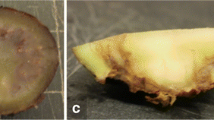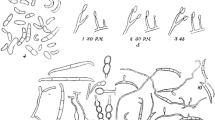Abstract
Isolates of Fusarium oxysporum from lily were screened for pathogenicity, vegetative compatibility and DNA restriction fragment length polymorphisms, and compared to reference isolates of F. oxysporum f.sp. gladioli and F. oxysporum f.sp. tulipae to justify the distinction of F. oxysporum f.sp. lilii. Twenty-four isolates from different locations in The Netherlands (18 isolates), Italy (4 isolates), Poland and the United States (1 isolate each) shared unique RFLP patterns with probes D4 and pFOM7, while hybridization did not occur with a third probe (F9). Except for a self-incompatible isolate, these 24 isolates all belonged to a single vegetative compatibility group (VCG 0190). Isolates belonging to VCG 0190 were highly pathogenic to lily, but not to gladiolus or tulip, except for a single nonpathogenic isolate. Six saprophytic isolates of F. oxysporum from lily were nonpathogenic or only slightly aggressive to lily, gladiolus and tulip, belonged to unique VCGs and had distinct RFLP patterns. Three pathogenic isolates previously considered to belong to F. oxysporum f.sp. lilii were identified as F. proliferatum var. minus; all three belonged to the same VCG and shared unique RFLP patterns. These three isolates were moderately pathogenic to lily and nonpathogenic to gladiolus and tulip. The reference isolates of F. oxysporum f.sp. tulipae were pathogenic to tulip, but not to lily and gladiolus; they shared a distinct RFLP pattern, different from those encountered among pathogenic and saprophytic isolates from lily, and formed a separate new VCG (VCG 0230). Reference isolates of F. oxysporum f.sp. gladioli belonging to VCG 0340 proved pathogenic to both gladiolus and lily, but not to tulip. These isolates, as well as isolates belonging to VCGs 0341, 0342 and 0343 of F. oxysporum f.sp. gladioli, had RFLP patterns different from those encountered among the isolates from lily or tulip. These findings identify F. oxysporum f.sp. lilii as a single clonal lineage, distinct from F. oxysporum f.sp. gladioli and f.sp. tulipae.
Similar content being viewed by others
References
Aloi C and Baayen RP (1993) Examination of the relationships between vegetative compatibility groups and races in Fusarium oxysporumf. sp. dianthi. Plant Pathology 42: 839-850
Armstrong GM and Armstrong JK (1975) Reflections on the wilt fusaria. Annual Review of Phytopathology 13: 95-103
Baayen RP(1992) Resistance mechanisms of plants to rot and wilt diseases caused by Fusarium oxysporum. Acta Horticulturae 325: 675-682
Baayen RP and Förch MG (1998) Transfer cell formation reveals a biotrophic phase in bulb rot of lilies infected by Fusarium oxysporumf. sp. lilii. In: Summerell B and Burgess LW (eds), Proceedings of the Paul E. Nelson Memorial Symposium, November 1997. APS Press, in press
Baayen RP, Van Dreven F, Krijger MC and Waalwijk C (1997) Genetic diversity in Fusarium oxysporumf. sp. dianthiand Fusarium redolensf. sp. dianthi. European Journal of Plant Pathology 103: 395-408
Blakemore EJA, Jaccoud Filho DS and Reeves JC (1994) PCR for the detection of Pyrenophoraspecies, Fusarium moniliforme, Stenocarpella maydis, and the Phomopsis/Diaporthecomplex. In: Schots A, Dewey FM, and Oliver R (eds), Modern assays for plant pathogenic fungi: identification, detection and quantification (pp. 205-213) CAB International, Wallingford, Oxford, U. K.
Boerema GH and Hamers MEC (1988) Check-list for scientific names of common parasitic fungi. Series 3a: Fungi on bulbs: Liliaceae. Netherlands Journal of Plant Pathology 94, supplement 1: 1-32
Boerema GH and Hamers MEC (1989) Check-list for scientific names of common parasitic fungi. Series 3b: Fungi on bulbs: Amaryllidaceae and Iridaceae. Netherlands Journal of Plant Pathology 95, suppl. 3: 1-32
Bosland PW and Williams PH (1987) An evaluation of Fusarium oxysporumfrom crucifers based on pathogenicity, isozyme polymorphism, vegetative compatibility, and geographic origin. Canadian Journal of Botany 65: 2067-2073
Correll JC (1991) The relationships between formae speciales, races, and vegetative compatibility groups in Fusarium oxysporum. Phytopathology 81: 1061-1064
Correll JC, Klittich CJR and Leslie JF (1987) Nitrate nonutilizing mutants of Fusarium oxysporumand their use in vegetative compatibility tests. Phytopathology 77: 1640-1646
Elias KS, Zamir D, Lichtmann-Pleban T and Katan T (1993) Population structure of Fusarium oxysporumf. sp. lycopersici: restriction fragment length polymorphisms provide genetic evidence that vegetative compatibility group is an indicator of evolutionary origin. Molecular Plant-Microbe Interactions 6: 565-572
Elmer WH and Stephens CT (1989) Classification of Fusarium oxysporumf. sp. asparagiinto vegetatively compatible groups. Phytopathology 79: 88-93
Elmer WH and Vossbrinck CR (1997) Ribosomal DNA sequences from the ITS regions differ between vegetatively incompatible isolates of Fusarium proliferatumfrom asparagus. Phytopathology 87: S28
Elmer WH, Wick RL and Haviland P (1994) Vegetative compatibility among Fusarium oxysporumf. sp. basilicumisolates recovered from basil seed and infected plants. Plant Disease 78: 789-791
Fernandez D, Ouinten M, Tantaoui A and Geiger JP (1997) Molecular records of micro-evolution within the Algerian population of Fusarium oxysporumf. sp. albedinisduring its spread to new oases. European Journal of Plant Pathology 103: 485-490
Gerlach W and Nirenberg HI (1982) The genus Fusarium- a pictorial atlas. Mitteilungen aus der Biologischen Bundesanstalt für Land-und Forstwirtschaft, Berlin-Dahlem 209: 1-406
Jacobson DJ and Gordon TR (1990) Variability of mitochondrial DNA as an indicator of relationships between populations of Fusarium oxysporumf. sp. melonis. Mycological Research 94: 734-744
Gordon TR and Martyn RD (1997) The evolutionary biology of Fusarium oxysporum. Annual Review of Phytopathology 35: 111-128
Kistler HC (1997) Genetic diversity in the plant-pathogenic fungus Fusarium oxysporum. Phytopathology 87: 474-479
Kistler HC, Bosland PW, Benny U, Leong S and Williams PH (1987) Relatedness of strains of Fusarium oxysporumfrom crucifers measured by examination of mitochondrial and ribosomal DNA. Phytopathology 77: 1289-1293
Leslie JF (1993) Fungal vegetative compatibility. Annual Review of Phytopathology 31: 127-150
Linderman RG(1981) Fusariumdiseases of flowering bulb crops. In: Nelson PE, Toussoun TA, and Cook RJ (eds), Fusarium: diseases, biology and taxonomy (pp. 129-141) Pennsylvania State University Press, University Park, Pennsylvania, U. S. A.
Löffler HJM and Mouris JR (1992) Bulb rot of Liliumcaused by isolates of different formae speciales of Fusarium oxysporum. Plant Breeding, Acclimatization and Seed Production 37: 95-103
Löffler HJM and Rumine P (1991) Virulence and vegetative compatibility of Dutch and Italian isolates of Fusarium oxysporumf. sp. lilii. Journal of Phytopathology 132: 12-20
Löffler HJM, Straathof ThP, Mouris JR and Baayen RP (1995) Durability of resistance in lily to basal rot: evaluation of virulence and aggressiveness among isolates of Fusarium oxysporumf. sp. lilii. European Journal of Plant Pathology 101: 261-271
Manicom BQ and Baayen RP (1993) Restriction fragment length polymorphisms in Fusarium oxysporumf. sp. dianthiand other fusaria from Dianthusspecies. Plant Pathology 42: 851-857
Manicom BQ, Bar-Joseph M, Rosner A, Vigodsky-Haas H and Kotze JM (1987) Potential applications of random DNA probes and restriction fragment length polymorphisms in the taxonomy of the fusaria. Phytopathology 77: 669-672
McClellan WD (1945) Pathogenicity of the vascular Fusariumof gladiolus to some additional iridaceous plants. Phytopathology 35: 921-930.
Mes JJ, Van Doorn J, Roebroeck EJA, Van Egmond E, Van Aartrijk J and Boonekamp PM (1994) Restriction fragment length polymorphisms, races and vegetative compatibility groups within a worldwide collection of Fusarium oxysporumf. sp. gladioli. Plant Pathology 43: 362-370
Migheli Q, Berio T, Gullino ML and Garibaldi A (1995) Electrophoretic karyotype variation among pathotypes of Fusarium oxysporumf. sp. dianthi. Plant Pathology 44: 308-315
Puhalla JE (1985) Classification of strains of Fusarium oxysporumon the basis of vegetative compatibility. Canadian Journal of Botany 63: 179-183
Raeder U and Broda P (1985) Rapid preparation of DNA from filamentous fungi. Letters in Applied Microbiology 1: 17-20
Roebroeck EJA and Mes JJ (1992a) Physiological races and vegetative compatibility groups within Fusarium oxysporumf. sp. gladioli. Netherlands Journal of Plant Pathology 98: 57-64
Roebroeck EJA and Mes JJ (1992b) Biological control of Fusariumin gladiolus with non-pathogenic Fusariumisolates. Acta Horticulturae 325: 769-779
Simay EI (1990) Garlic rot caused by Fusarium proliferatum(Matsushima) Nirenberg var. minusNirenberg in Hungary. Novenyvedelem 26: 397-399
Straathof ThP, Jansen J and Löffler HJM (1993) Determination of resistance to Fusarium oxysporumin lily. Phytopathology 83: 568-572
Tantaoui A, Ouinten M, Geiger JP and Fernandez D (1996) Characterization of a single clonal lineage of Fusarium oxysporumf. sp. albediniscausing Bayoud disease of date palm in Morocco. Phytopathology 86: 787-792
Waalwijk C and Baayen RP (1995) Identification of races of Fusarium oxysporumf. sp. dianthiby DNA fingerprinting and vegetative compatibility. Bulletin OEPP/EPPO Bulletin 25: 117-124
Waalwijk C, Baayen RP, De Koning JRA and Gams W (1996a) Ribosomal DNA analyses challenge the status of Fusariumsections Liseolaand Elegans. Sydowia 48: 90-104
Waalwijk C, De Koning JRA, Baayen RP and Gams W (1996b) Discordant groupings of Fusariumspp. from sections Elegans, Liseolaand Dlaminiabased on ribosomal ITS1 and ITS2 sequences. Mycologia 88: 361-368
Woudt LP, Neuvel A, Sikkema A, Van Grinsven MQJM, De Milliano WAJ, Campbell CL and Leslie JF (1995) Genetic variation in Fusarium oxysporumfrom cyclamen. Phytopathology 85: 1348-1355
Author information
Authors and Affiliations
Rights and permissions
About this article
Cite this article
Baayen, R., Förch, M., Waalwijk, C. et al. Pathogenic, Genetic and Molecular Characterisation of Fusarium oxysporum f.sp. lilii. European Journal of Plant Pathology 104, 887–894 (1998). https://doi.org/10.1023/A:1008676729143
Issue Date:
DOI: https://doi.org/10.1023/A:1008676729143




